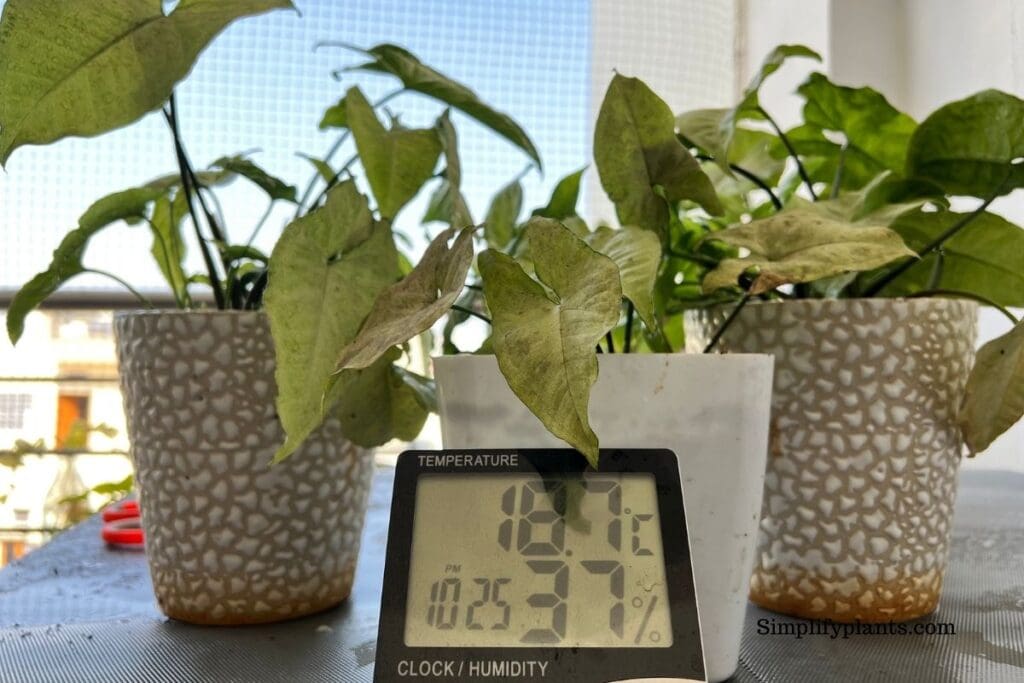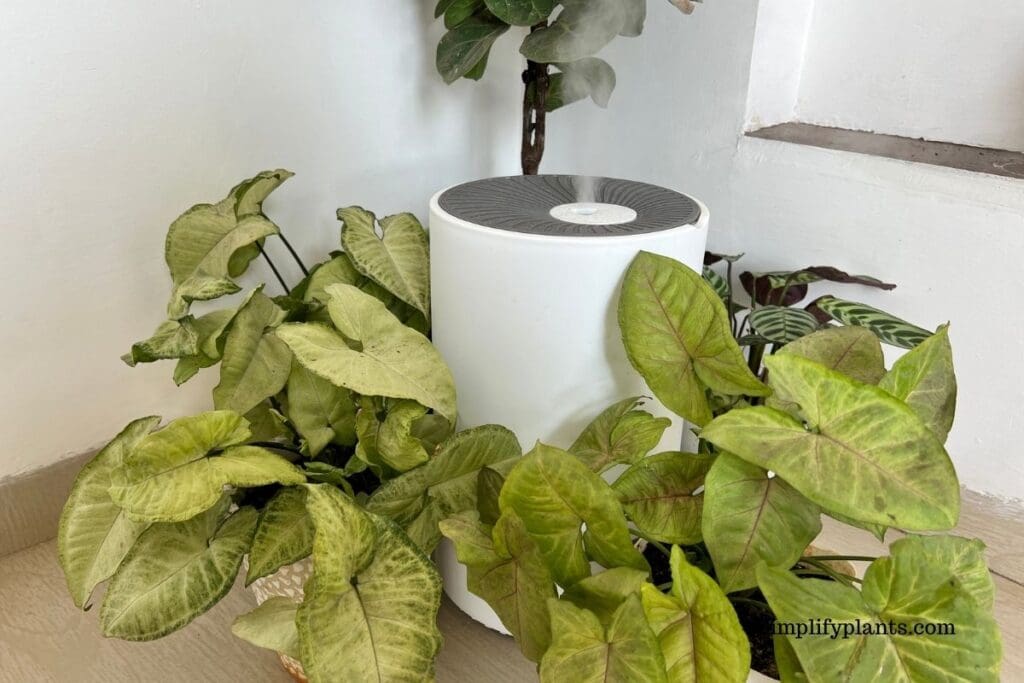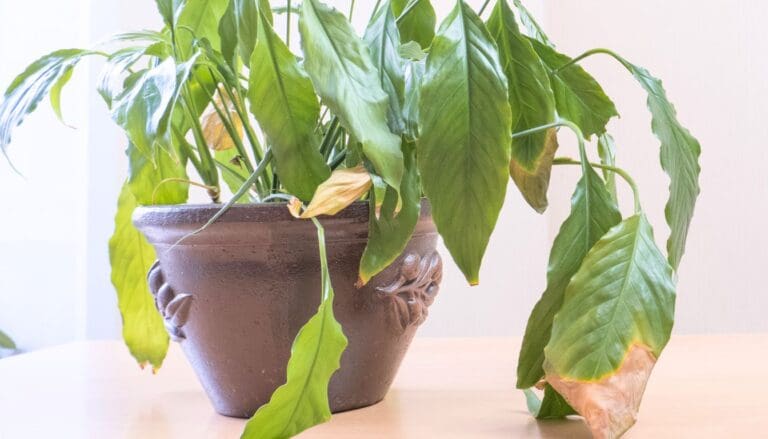Do Arrowhead Plants Like Humidity? (+Misting?)
Arrowhead plant or Syngonium is a tropical plant loved for its easy care requirement and spade-shaped leaves. The care routine of the arrowhead plant is incomplete without humidity, and we are going to find out do arrowhead plants like humidity?
In general, Arrowhead plants come from a tropical environment, so they prefer high humidity. The ideal humidity requirement for these plants is over 60%, but average humidity levels of 40-50% are also suitable for your Syngonium. Use a pebble tray or humidifier to maintain high humidity.
In this article, we will understand the humidity preference of arrowhead plants and different techniques for raising the humidity, especially during the dry winter months.

Please note: Simplify Plants is reader-supported. Some links in the post are affiliate links and I get a commission from purchases made through links in the post.
Do arrowhead plants like humidity?
Arrowhead plants come from tropical rainforests of America, where they receive over 70% humidity during the day and around 95% humidity during the night.
High humidity levels encourage the growth of the arrowhead plants and help them remain healthy.
If you can mimic the humidity levels of the native lands of the arrowhead plants, you will find them at their best state.
Before we discuss how to raise the humidity levels for the arrowhead plant, let’s understand why humidity plays an important role.
The transpiration process of plants depends on the humidity levels.
Transpiration is the process by which plants allow the water to evaporate through the stomata of the leaves.
However, if the humidity levels are low, the stomata of the leaves don’t open, so transpiration doesn’t occur as the leaves try to save the moisture.
Without transpiration, photosynthesis slows down, and the plant cannot generate enough energy for its growth.
Therefore, the growth of your arrowhead plant is compromised when the humidity levels are low.
You should be extra careful about the humidity during winter as the air loses a lot of moisture and becomes dry in this season.
Tropical plants such as arrowhead plants can face serious difficulty if exposed to very low humidity levels, especially during winter when the other conditions also become unsuitable.
How to determine the humidity level of your room?

If you are not aware of the humidity level around your Syngonium, you can use a hygrometer to determine it.
It is important to determine the humidity levels of the room.
Otherwise, you will not understand if your arrowhead plant receives sufficient humidity.
Different rooms have different humidity levels.
For example, your bedroom and living room will have lower humidity levels than the kitchen, bathroom, or basement.
The humidity level is also dependent on factors like seasons, temperature, and weather conditions.
Therefore, you can get a hygrometer, a small and portable device, and use it to measure the relative humidity of your rooms and around your plant.
Hygrometers are available online, so you can order one.
Signs your arrowhead plant needs humidity
If the humidity levels are low and your Syngonium is not receiving enough humidity, it will show you some signs.
Here are some common signs:
- Brown edges on leaves
- Crispy leaves
- Wilting leaves
- Yellow leaves
- Droopy leaves
You must inspect the plant thoroughly as these signs can also indicate other problems.
But if you don’t find any other problems, check the humidity level with a hygrometer and take steps to raise it if the levels are low.
How to provide humidity to arrowhead plants?
Take a look at some ways of raising the humidity around your arrowhead plant.
1. Install a humidifier

Getting a humidifier for your arrowhead plant is the most effective way of providing humidity to the plant.
You can place your arrowhead plant in the same room if you already have a humidifier.
If not, you can purchase a good quality humidifier to provide more humidity to your Syngonium and other humidity-loving plants.
When going for a humidifier, get one that can cover the whole room.
The best thing about a humidifier is that you can control the humidity level and even mimic the native humidity levels of the arrowhead plants.
2. Get a moss pole
Arrowhead plants start vining after maturing, so you can get a moss pole to support the plant.
The best thing about moss poles is that they also increase the humidity levels around the plant.
Moss absorbs and retains moisture, providing humidity to your arrowhead plant when that moisture evaporates.
You can get moss poles from your local nursery or purchase one online.
3. Prepare a pebble tray
Pebble trays are easy to prepare. All you need is:
- A tray
- Some pebbles
- Water
Take a tray, put some pebbles on it, and add some water.
Now, place the pot of your arrowhead plant on top of the pebbles.
Ensure that the water doesn’t touch the drainage holes, making the soil soggy.
The moisture around your arrowhead plant will increase when the water evaporates from the tray.
4. Group your Syngonium with other houseplants

One easy way to increase the humidity around your arrowhead plant is by grouping it with other humidity-loving plants.
The plants raise the humidity levels around themselves by transpiration.
When the plants transpire, they release some moisture into the air, increasing the humidity.
However, keeping the plants too close to each other can restrict airflow, so keep some space between them to allow proper air circulation.
5. Get an aquarium
An aquarium can also help in raising the humidity around your Syngonium.
If you already have an aquarium in the house, you can place your arrowhead plant near the aquarium.
The water of the aquarium evaporates and raises the humidity levels.
If you don’t have it, you can get one as it will serve as beautiful home decor besides increasing the humidity.
You can even use the water of the aquarium to fertilize your houseplants.
Instead of throwing it away while changing the water, use it to water the plants as this water is Nitrogen-rich due to the presence of fish poop.
6. Place bowls of water around your Syngonium
This is also an easy way of increasing the humidity if you don’t want to go for the other options.
Take some bowls and fill them with water.
Now, place these bowls around your arrowhead plant.
The humidity levels will rise when the water evaporates from these bowls.
7. Reduce the room temperature

Higher temperatures hold less moisture than lower temperatures.
If the temperature is high in the room where your arrowhead plant is placed, you can try reducing the room temperature.
But keep in mind that the temperature should still be suitable for the plant and don’t reduce it suddenly as that will shock the plant.
Lower the room temperature gradually so your Syngonium can adjust with it.
8. Get a mini indoor greenhouse.
Indoor greenhouses are created to give the ideal living conditions similar to the natural habitats to plants.
You can create a greenhouse with a plastic or glass box or get one online.
These mini greenhouses work as indoor decors, along with providing humidity to your houseplants.
Choose the size of the greenhouse based on the size of your Syngonium.
Should I mist my arrowhead plant?
Misting is a popular way of increasing the humidity around the houseplants, but it is not a long-term solution.
Misting increases the humidity levels only for a short period, and it will not work well in areas with humidity levels lower than 40%.
This is because as soon as you mist the plant, the water droplets start evaporating.
All the moisture gets used up within a few minutes.
You can mist your Syngonium occasionally, but it will not be sufficient.
You would need to use any of the methods mentioned earlier to increase the humidity for the long run.
However, avoid misting if the relative humidity level is already 60% or more.
If you mist the plants already getting enough humidity, the excess moisture will only encourage fungal and bacterial growth.
Let’s look at the opinions of people who support misting and who are totally against it.
| Misting supporters | Misting opposers |
|---|---|
| Misting provides humidity to the plants. | Misting can encourage bacterial and fungal diseases. |
| Misting with a neem oil solution can prevent pests. | Misting works only for a short while. |
| Misting helps to clean the foliage. | Misting can damage the leaves of the plant. |
Keeping all these factors in mind, I recommend misting the Syngonium occasionally.
Don’t depend solely on misting to increase the humidity, as it will not suffice.
You would need to mist your arrowhead plant in areas with low humidity every few minutes, which is not a practical solution.
Final thoughts
Humidity is important for tropical plants like the arrowhead plant or Syngonium, so you must try to provide humidity levels above 70% and don’t let it drop below 40-50%, especially during winters when the air becomes extremely dry.
You can get a humidifier, prepare a pebble tray, group your Syngonium with other plants, or use any of the other methods mentioned in this article to increase the humidity levels for the plant.
However, don’t consider misting to raise the humidity levels as it is not a practical solution and will not work in the long run. You can occasionally mist with a neem oil solution to keep pests away and clean the leaves.
Reference: CABI, Britannica, United States Department of Agriculture, Wikipedia, Children’s Health Queensland Hospital and Health Service, Missouri Botanical Garden.
Recommended Garden Supplies
| Product Image | Our Recommended Gardening Supplies | Check Offers! |
|---|---|---|
Top Top
Top
Top
Top
Top
Top
Top
Top | rePotme Houseplant and Tropical Classic Potting Soil Mix | Check Offer On Amazon |
 Top
Top
Top
Top
Top
Top
Top
Top | Espoma Organic Indoor Plant Food | Check Offer On Amazon |
 Top
Top
Top
Top
Top
Top
Top
Top | GooingTop LED Grow Light 6000K Full Spectrum Clip Plant Growing Lamp | Check Offer On Amazon |
 Top
Top
Top
Top
Top
Top
Top
Top | Soil Moisture Meter | Check Offer On Amazon |
 Top
Top
Top
Top
Top
Top
Top
Top | Govee Hygrometer Thermometer, Bluetooth Enabled! | Check Offer On Amazon |
 Top
Top | LEVOIT Humidifiers for Large Room(Best For Plants) | Check Offer On Amazon |
 Top
Top
Top
Top
Top
Top
Top
Top | Upgraded DIY Automatic Drip Irrigation Kit, 15 Potted Houseplants Support | Check Offer On Amazon |
 Top
Top
Top
Top
Top
Top
Top
Top | Stainless Steel Heavy Duty Gardening Tool Set | Check Offer On Amazon |
 Top
Top
Top
Top
Top
Top
Top
Top | Bonide Insecticidal Soap | Check Offer On Amazon |
 Top
Top
Top
Top
Top
Top
Top
Top | Bonide 32 oz Spray Neem Oil for Organic Gardening | Check Offer On Amazon |
 Top
Top
Top
Top
Top
Top
Top
Top | Garden Safe Fungicide | Check Offer On Amazon |






